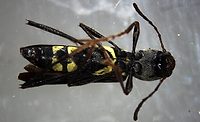Agriculture specialists with U.S. Customs and Border Protection (CBP) found live Khapra Beetle larvae and a number of dead adult beetles comingled within a shipment of rice from Saudi Arabia in Philadelphia earlier this month.
Considered one of the world’s most destructive insect pests of grains, cereals and stored foods, the Khapra Beetle remains the only insect in which CBP takes regulatory action against even while in a dead state. Because of the finding, USDA has taken action and implemented restrictions on certain products imported from countries where the beetles are known to occur.
“To see such a large concentration of larvae is alarming and it presents a serious threat to our nation’s agriculture. Customs and Border Protection agriculture specialists took immediate action to quarantine the rice and these highly destructive and invasive insect pests,” says Marge Braunstein, acting CBP port director for the area port of Philadelphia. “Safeguarding America’s agriculture industries remains an enforcement priority for CBP, and it’s a mission that we take very seriously.”
The shipment, which was destined to Fairborn, OH contained dried lemons, several open packages of herbs, and one open burlap bag of rice weighing more than six pounds. CBP agriculture specialists inspected a portion of the rice when they encountered the Khapra Beetle colony. CBP discovered additional Khapra Beetles in the bottom of the box. CBP destroyed the rice, dried lemons, and herbs.
The Khapra Beetle is labeled a ‘dirty feeder’ because it damages more grain than it consumes, and because it contaminates grain with body parts and hairs. These contaminants may cause gastrointestinal irritation in adults and especially sickens infants, according to CBP. Khapra Beetles can also tolerate insecticides and fumigants, and can survive for long periods without food.
According to the USDA Animal and Plant Health Inspection Service (APHIS), previous infestations of Khapra Beetle have resulted in massive, long term-control and eradication efforts at a great cost. California implemented extensive eradication measures following a Khapra Beetle infestation discovered there in 1953. The effort was deemed successful, but at a cost of approximately $90 million in today’s dollars




